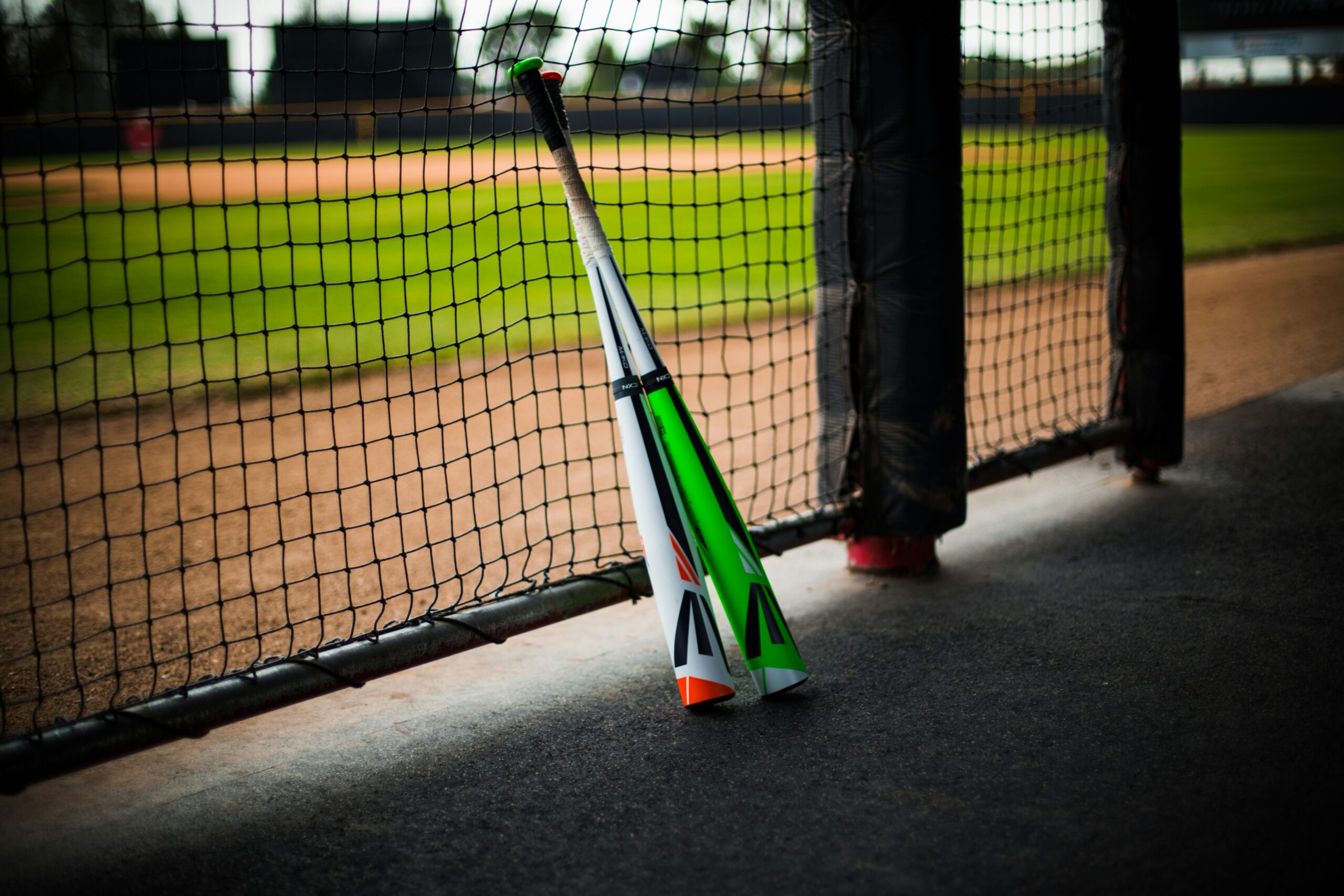Introduction to Baseball Bats
Baseball bats are essential equipment for players, significantly impacting performance and comfort during the game. The choice of bat material is vital, as it can influence factors such as swing speed, power, and control. The two primary materials used for manufacturing baseball bats are composite and aluminum, each boasting unique characteristics that cater to different playing styles and preferences.
Composite baseball bats are constructed from layered materials, typically carbon fiber, which provide a lightweight yet durable design. These bats often have a larger sweet spot and deliver a trampoline effect, allowing for increased energy transfer on contact with the ball. Players seeking improved swing mechanics and optimal distance often gravitate toward composite bats given their performance benefits. However, it is essential to account for the break-in period necessary for composite models to reach their peak performance, as they tend to require several hits to achieve their full potential.
On the other hand, aluminum baseball bats are known for their immediate responsiveness and consistent performance. These bats are usually heavier and exhibit a more rigid construction than their composite counterparts. A key advantage of aluminum bats is their durability; they can withstand repeated impacts without the need for a break-in period. This makes them a popular choice among recreational players and those participating in leagues where performance standards are less stringent. Individuals focusing on control and stability may find aluminum bats more suitable due to their predictable power and handling.
Ultimately, the selection of a baseball bat can have profound effects on a player’s game. Understanding the pros and cons of each material and how they align with personal playing style is crucial in making an informed choice. The upcoming sections will delve deeper into a direct comparison of composite and aluminum baseball bats, aiding in the decision-making process.
Understanding Composite Baseball Bats
Composite baseball bats are engineered using a mixture of materials that often include carbon fiber, fiberglass, and resin. This construction provides a lightweight feel, which allows players to generate faster swing speeds. The design of composite bats aims to maximize performance by creating a larger sweet spot compared to their traditional aluminum counterparts. This feature can be particularly beneficial for players who may not consistently hit the ball at the same spot on the bat’s surface.
One of the significant advantages of composite baseball bats is their ability to absorb vibration. This characteristic not only enhances comfort during play but also contributes to better control and accuracy when making contact with the ball. Additionally, composite bats can be made with varying levels of stiffness, allowing manufacturers to cater to different swing styles and preferences. As such, they are often recommended for players who prefer a balanced feel while swinging.
Furthermore, composite bats typically have a break-in period, a unique aspect that sets them apart from aluminum bats. During this period, the fibers within the bat gradually loosen, ultimately enhancing the overall performance and power. However, it is important to recognize that this initial adjustment phase means that composite bats may not perform at their peak immediately upon purchase. Players should also be aware that while these bats offer a high level of performance, they can be more susceptible to cracking under high-impact situations, thus requiring proper care and maintenance.
Considering the specific features and benefits, composite baseball bats are often ideal for players looking to elevate their game. They are particularly well-suited for developing players seeking optimal performance or advanced athletes focused on maximizing their hitting potential. However, each player’s unique style and needs should be taken into account when making a final decision regarding the choice between composite and aluminum baseball bats.
Understanding Aluminum Baseball Bats
Aluminum baseball bats have become a staple in the sport due to their unique construction and performance characteristics. Unlike their composite counterparts, aluminum bats are typically made from an alloy of aluminum, often enhanced with additional materials for improved performance. The manufacturing process generally involves an extrusion method, where aluminum is forced through a die to create a hollow tube. This process contributes to the lightweight yet durable nature of aluminum bats.
One of the primary advantages of aluminum baseball bats is their superior durability. Unlike composite bats, which can crack or dent upon repeated use, aluminum bats tend to withstand the rigors of play far better. This durability makes them a favorite choice among players at various levels, as they require less frequent replacements. Furthermore, aluminum bats often require little to no break-in period, allowing players to maximize their performance from the moment they first use the bat.
The performance consistency of aluminum bats is another notable benefit. They provide a solid “ping” upon contact with the ball, which many players find gratifying. This sound, alongside the consistent feel during swings, contributes to a player’s confidence when at bat. Additionally, the balanced weight distribution in many aluminum designs allows for improved swing speed, which can enhance a player’s hitting potential.
However, there are some potential downsides. While aluminum bats do not require a break-in period, their performance may plateau over time as they sustain use and wear. Moreover, some players may prefer the flex and trampoline effect of composite bats, which can contribute to increased distance on hits. In summarizing the advantages and disadvantages of aluminum baseball bats, it becomes evident that these bats serve as a reliable choice, particularly for those valuing durability and immediate performance.
Performance Comparison: Power and Distance
When evaluating the performance of composite baseball bats and aluminum baseball bats, power and distance are of paramount importance for players seeking optimal hitting effectiveness. Each bat type exhibits unique characteristics influenced by its materials, consequently affecting a player’s swing speed and the ball’s exit velocity upon impact.
Composite baseball bats are crafted from layered materials, often featuring advanced resin systems that enhance flexibility and energy transfer. When a player makes contact with the ball, the bat’s design allows it to flex, storing energy that is then released to propel the ball. This energy transfer often results in higher exit velocities, thereby increasing the distance the ball travels. Players may experience a significant feel and control when utilizing composite bats, which can contribute to improved swing power over prolonged usage as they “break in” with consistent contact.
Conversely, aluminum baseball bats consist of a single-piece or multiple-piece alloy construction, resulting in a structure that is typically stiffer than their composite counterparts. While these bats may not exhibit the same energy transfer capabilities, they are known for their durability and consistent performance throughout their lifespan. Aluminum bats provide players immediate responsiveness upon contact, allowing them to achieve impressive swing speeds. However, the potential for distance may be slightly diminished compared to composite bats due to the lower coefficient of restitution (COR) associated with aluminum materials.
Ultimately, the choice between composite and aluminum baseball bats boils down to personal preferences and playing styles. Each type offers unique advantages in terms of power potential and ball distance. A careful analysis of each bat’s physical properties can aid players in finding the right fit to enhance their hitting performance, thus making informed decisions when selecting between these two primary options in baseball bats.
Durability and Longevity
The durability of baseball bats is a critical factor for players when choosing between composite and aluminum options. Generally speaking, aluminum baseball bats are recognized for their robust construction and ability to withstand significant wear and tear. This metal composition allows them to retain their performance level over time, making them a reliable choice for avid players. They exhibit excellent resistance to denting as well, meaning that regular use will not lead to quick deterioration. However, while aluminum bats can offer longevity, they may not perform as consistently after prolonged use due to structural fatigue.
On the other hand, composite baseball bats are known for their lightweight and higher initial performance. They are engineered from layered materials, which can contribute to their ease of use. However, they tend to have a different longevity profile. Over time, composite bats can experience a reduction in their performance level, particularly if they are exposed to extreme temperatures or improper handling. While many composite bats are designed with a durable structure, they are still susceptible to cracking or breaking, especially if frequently used for practices or games against tough pitches.
When it comes to maintenance, both bat types require different considerations. Aluminum bats may need regular cleaning to avoid corrosion, while composite bats should be stored properly to avoid temperature-related issues. Moreover, players should be attentive to minor damages, as quick repairs can prolong the life of both types. While both bat varieties can be repaired, it is often easier and more cost-effective to mend aluminum bats, given their simpler construction.
In conclusion, when evaluating durability and longevity, aluminum baseball bats may offer a longer-lasting option under regular conditions, while composite bats provide superior performance initially but require more careful handling and maintenance. Understanding these aspects can help players make an informed comparison based on their playing style and needs.
Price Range and Budget Considerations
When deliberating between composite baseball bats and aluminum baseball bats, understanding the price range and budget considerations is vital for making an informed decision. Generally, baseball bats can vary significantly in cost depending on several factors including brand reputation, materials, and technological advancements. Composite bats typically lie at a higher price point, often ranging from $150 to $500, owing to their advanced engineering and materials designed to enhance performance. In contrast, aluminum bats are usually more affordable, with prices typically ranging from $50 to $300.
The difference in pricing can be attributed to the manufacturing processes and performance features of the two types of bats. Composite baseball bats are often equipped with multi-layered materials allowing for greater weight distribution and improved trampoline effect upon ball contact, which can justify their higher costs. Conversely, aluminum bats, while providing durability and a history of reliable performance, usually utilize simpler manufacturing processes which allow for lower price points.
Another important factor influencing the price is the brand. Established brands with high reputations in the sports equipment industry often charge premium prices for their bats, anticipating that consumers will pay more for perceived quality and reliability. Nevertheless, this does not imply that lesser-known brands do not offer valuable options; they may provide a practical alternative for budget-conscious players seeking solid performance without breaking the bank.
Ultimately, determining the right bat involves balancing personal preference and performance needs against the budget. While it may be tempting to opt for the least expensive option, it is essential to consider the benefits of investing in higher-quality baseball bats that may offer better performance and longevity over time.
Player Preference: Comfort and Feel
When it comes to choosing between composite and aluminum baseball bats, player preference plays a significant role, particularly regarding comfort and feel. Each type of bat offers distinct characteristics that can influence a player’s performance and enjoyment on the field. The choice often comes down to how a bat feels during swings and impacts, as well as individual grip preferences.
Composite baseball bats are typically designed to provide a softer feel upon contact, which can be advantageous for players seeking a cushioned experience. This sensation is partly due to the materials used, which often allow for greater flex upon impact, enhancing the “trampoline effect.” Many players report that the smooth feel of a composite bat leads to better control and feedback, helping them feel more connected with the ball during play. Additionally, the wider sweet spot that these bats generally provide can enhance confidence, particularly during high-pressure situations.
On the other hand, aluminum baseball bats tend to offer a denser feel and a more rigid structure. This rigidity can translate into higher energy transfer upon impact, making for a firmer connection with the ball. Some players appreciate this direct feedback, describing it as a satisfying experience when hitting a pitch. Moreover, aluminum bats often feature a range of grip options, which can allow players to customize their hold for optimal comfort. For athletes who prioritize precision and a strong sense of impact, aluminum bats may be the preferred choice.
Ultimately, comfort and feel are subjective and can vary greatly from player to player. Trying out different models and styles can help players determine what suits them best. It is essential to consider how the bat makes a player feel during an at-bat, as personal preference significantly influences performance, making the comparison integral in decision-making.
Regulations and Standards for Youth and Adult Leagues
When selecting baseball bats, it is imperative for players to understand the regulations and standards imposed by different leagues, as these guidelines directly influence the type of bats that can be utilized during games. Both youth and adult baseball leagues have specific rules regarding the use of composite and aluminum baseball bats, often aimed at ensuring player safety, maintaining a fair competitive environment, and standardizing equipment across the board.
In youth leagues, organizations such as Little League and Cal Ripken impose strict regulations on the types of bats that players can use. For instance, many youth leagues permit the use of both composite and aluminum bats, but they must bear the appropriate certification mark, such as the BPF 1.15 or USA certification logo. These regulations primarily ensure that bats meet safety standards while providing a consistent playing experience. As a result, parents and guardians should carefully check these certifications when purchasing bats for young players.
High school leagues, including those governed by the National Federation of State High School Associations (NFHS), also have specific regulations. The NFHS allows the usage of both composite and aluminum bats; however, bats must meet the BBCOR (Batted Ball Coefficient of Restitution) standard. This benchmark is designed to minimize the performance gap between BBCOR-certified bats and wooden bats, thereby promoting a level playing field. For players participating in high school baseball, selecting a bat that meets this standard is critical.
Adult leagues, like the Amateur Softball Association (ASA) and the National Adult Baseball Association (NABA), typically have fewer restrictions. However, players should still consult each league’s specific regulations on allowable bat types, as some leagues may impose restrictions on composite bats to maintain fairness and competitiveness. Understanding these regulations is vital for choosing the right baseball bat that adheres to league rules and ensures compliance during play.
Conclusion: Choosing the Right Bat for Your Needs
When it comes to selecting the right baseball bat, the decision ultimately hinges on personal preference, playing style, and specific needs. The comparison between composite and aluminum baseball bats reveals distinct characteristics that cater to different segments of players. For those prioritizing ease of swing and greater flex, composite bats may be the preferred choice. Their construction allows for increased trampoline effect, generating enhanced power on contact. This makes them appealing for power hitters seeking to maximize their performance at the plate.
On the other hand, aluminum bats offer durability and instant performance straight out of the bat rack. Their sturdiness translates to reliability and long-lasting use, making them an attractive option for players who participate in numerous games and practice sessions. Furthermore, aluminum bats deliver a consistent feel and sound upon contact, providing immediate feedback which can be crucial for developing players still refining their batting techniques.
As baseball continues to evolve, it is essential for players to experiment with various bat types to determine their comfort and effectiveness. Factors such as weight, length, grip, and barrel size should be assessed in conjunction with the material of the bat. Additionally, players should consider league regulations, as some competitions have specific restrictions regarding bat materials. By understanding the key differences highlighted in this comparison, players can make informed choices tailored to their individual preferences.
Ultimately, whether one opts for a composite or aluminum bat, the right baseball bat will enhance one’s performance on the field. Therefore, take time to analyze the advantages and limitations of each option to ensure that your selection aligns with your playing style and helps you achieve your best performance in the game.




